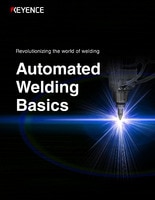Welding glossary
There are many technical terms used for welding. The following table lists basic welding terms. There may be other terms specific to individual welding methods.
| Term | Description |
|---|---|
| B | |
| Base material | Material to be welded in a process where a filler material is used. When a filler material is not used, it is called "weld material." |
| Bead | The elevation of the joint surface consisting of finished weld. |
| Beam scan welding | A method in which laser beam is applied to the welding point using a polarized mirror. The term “beam scan welding” comes from how the laser beam tracks across (“scans”) a fixed base material. |
| Butt welding | A welding technique that makes the surfaces of the weld joint and base material almost flush with each other. |
| F | |
| Filler material | A wire or a welding rod used to join the base materials. |
| Fillet | A weld joint with a triangular cross section that joins two surfaces together at approximately 90 degrees. |
| Flux | Material used for cleaning and activating the surface of the base material and improving the fluidity of the filler material. |
| Fume | Solid particles formed when a solid vaporizes once and then condenses through rapid cooling. |
| G | |
| Groove | A beveled opening created in a weld joint before welding to achieve necessary penetration. |
| H | |
| Heat-affected zone (HAZ) | The area of the base material that is not melted but whose microstructure and properties are changed due to heat during welding. |
| I | |
| Ionizing voltage | The voltage at which the outermost orbital electrons in an atom become ionized (sent outside the atom). |
| J | |
| Joule heat | Heat generated inside a conductor by electrical resistance when an electric current flows through the conductor. |
| M | |
| Manipulator | A robot that operates with a multi-joint structure and a servo motor. The movable range varies depending on the number of joints (axes). It can be used for various operations through the replacement of hand pieces attached to the end. |
| P | |
| Pass | One welding progression made along a weld joint. |
| Penetration | The distance between the top of the base material melted by welding and the original surface of the base material. |
| Plasma (laser-induced plume) | A gas containing charged particles generated by ionization. |
| S | |
| Shielding gas | Gas used to block out atmosphere in order to prevent the oxidization or nitriding of molten metal during welding.
|
| Slag | Non-metallic substances that form on the weld. The molten slag remaining inside weld metal is called slag inclusion and is a welding defect. |
| Spatter | The scattering of slag or metal droplets during welding which typically degrades welding quality. |
| T | |
| Tailored blank (TB) | Material for press working created through the welding of combinations of multiple steel sheets with different materials and properties to enhance strength and anticorrosion properties. |
| W | |
| Weaving | A welding motion typically used for arc welding that moves the torch from side-to-side almost perpendicular to the weld line. This motion can deposit more weld metal with fewer passes. |
| Welding defect | A defect resulting from abnormal welding caused by the inclusion of weld metal, inappropriate welding technique or welding parameters. |
| Weld joint | A joint between base materials. |
| Weld line | A line representing a bead or a weld. A line to be welded, a line being welded or a welded line. |
| Weld pool | A puddle of molten metal created after the electrode or base material is melted by arc heat or other causes during welding. |




